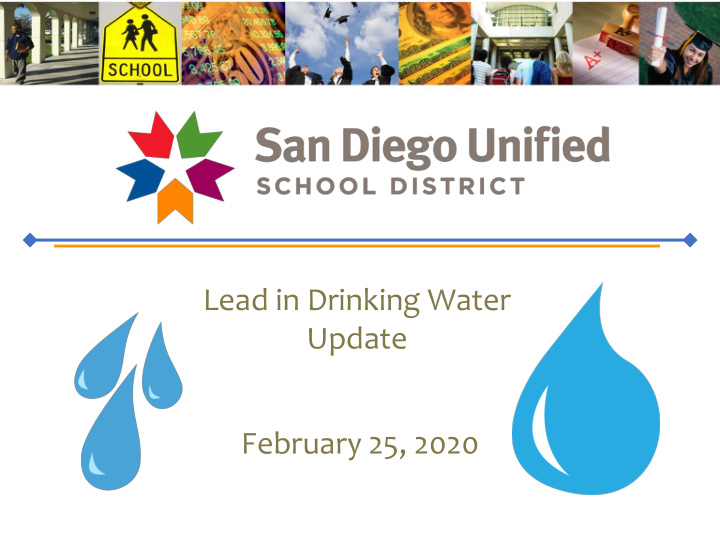



Lead in Drinking Water Update February 25, 2020
How We Got Here • 2015: Public health crisis in Flint, MI triggers nationwide conversation about lead in drinking water. • December 2016: SWRCB Division of Drinking Water requires local water providers to test schools’ drinking water if asked. • April-June 2017: City of San Diego conducts water sampling at SDUSD sites. • All tested fountains with lead above 15 parts per billion (ppb) secured, remediated, or removed. • July 2017 District implements 5 ppb City employee drawing first sample of water, standard. April 2017 2
Current Status • There are no known water outlets exceeding 5 ppb that have not been resolved. • All schools with any initial sample result exceeding 5 ppb (City or District testing): • Every drinking water outlet on those sites tested and remediated as necessary. 3
Lead in Drinking Water Samples 2,467 Drinking Water Outlets – Initial Sampling • Action Taken – Those 40 school 1% sites with any initial sampling 12% result above 5 ppb: • All drinking water outlets on site tested • All fully resolved 87% to below 5 ppb • Higher lead content typically found in drinking water outlets with Less than 5ppb minimal use 5 - 15 ppb Greater than 15 ppb 4
Proposed Actions • Provide drinking water solely through filtered water outlets. • Point of use filters as close to water outlet as possible • Replace drinking water fountains with strategically located, ADA compliant, filtered Hydration Stations • Hydration Station is a combination drinking fountain/bottle filling station • Remove remaining drinking fountains - Fewer drinking water outlets, but of a higher quality • With bottle filling stations, water is more portable • Confirmation testing after filter installation and random quality assurance testing of filtered outlets to ensure continued filter performance. • Discontinue whole-site testing in advance of new unit and filter installation. • Restate the District’s drinking water policy on lead content. 5
Proposed District Drinking Water Policy All drinking water outlets will provide filtered water that is expected to reduce lead in water content to below one part per billion . Through continued quality assurance sampling of water, any water outlet that tests for lead content above five parts per billion will be immediately removed from service. 6
Impact of Proposed Policy • Elimination of drinking fountain “bubbler” in elementary classroom • Sink to remain for hand washing, etc. • Successful completion of Clay ES Pilot • Initial outfitting performed by PPO and FPC • Funded by Prop YY • PPO taking lead in conversions • FPC installing in new buildings and as part of Whole Site Modernizations • Cost to maintain filters • Approximately $200 per filter per year (Approx. $400,000 annually) • Added cost to General Fund/Routine Restricted Maintenance Account • Added benefits • Filtering other possible contaminants • Water is more portable - promoting hydration • Potential reduction in plastic single use bottles Clay Elementary students at new Hydration Station 7
Implementation of Proposed Policy • Filters added to existing water outlet locations in: • Kitchen for food preparation (not required for dish washing) • Nurse’s office • Teachers’ Lounge/Staff break area • Shift from ~10,000 unfiltered water fountains to ~ 2,000 Filtered Hydration Stations. Typical locations: • Cafeteria/multi-purpose room • Gymnasium • Strategic locations throughout campus to meet 1 per 150 people (Plumbing Code) • On upper floors of multi-story buildings • Exterior locations near play areas and athletic fields 8
Timeline • Hydration Station program • 48 stations installed @ 8 Elementary/K-8 sites • To date, Clay is the only school with all non-filtered fountains removed. • All sites complete by August 2024 • As lead has a greater impact on the youngest children, implementation will follow: • Elementary Schools, then • Middle Schools, then • High Schools 9
Prioritizing Health • Plan developed to prioritize student and staff health • PPO, FPC, Nursing and Wellness, Legal, Industrial Hygienist, CALPIRG • Safety key points: • Schools with the highest chance of lead in water dealt with first • All with initial sampling results > 5 ppb resolved • Flushing outlets helps • Daily/weekly flushing • Concentrated effort over longer periods (return from winter/summer breaks) • Elementary before Secondary • Lead ingestion more impactful to young children • District has been conservative • District standard 3x more stringent than Federal standards • Early on where high levels of lead encountered in water outlets, blood testing did not demonstrate school of lead contributing to high blood lead level 10
Questions and Answers 11
Recommend
More recommend